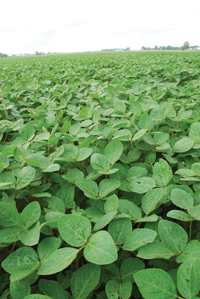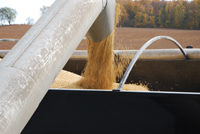
Features
Agronomy
Insect Pests
Manganese-glyphosate spring update
The quest for higher soybean yields in soils with manganese deficiency can be an expensive and time-consuming effort.
April 2, 2010 By Blair Andrews
The quest for higher soybean yields in soils with manganese deficiency can be an expensive and time-consuming effort. Farmers who require a manganese application are more likely to spray their fields with the nutrient about a week after applying glyphosate rather than using a tank-mix option. The reason for not mixing the two is the risk of losing weed control by antagonizing the glyphosate.

|
| Plants need manganese for photosynthesis during the active vegetative state.
|
With the goal of saving growers time and money, Ontario crop advisors in Lambton County have been testing a potential tank-mix option. So far Brian Hoven and John Waters of Lakeside Grain and Feed have had good results with a relatively new product in Canada called Max-In Manganese NF 2.00. In Hoven’s latest trials, tank-mixing the foliar product with Roundup Weather-Max produced similar yields as applying manganese separately. “We wanted to prove that it wasn’t holding back yield and it wasn’t tying up spray efficacy; we wanted to prove you could mix them,” says Hoven, commenting on the fields trials that combined glyphosate with Max-In.
The 2009 testing of the product during the crop season was the latest assessment under Ontario conditions. Max-In is a product from Winfield Solutions, LLC, and is distributed in Canada by the Agromart retail group. Developed with built-in adjuvants, it uses a highly soluble micronutrient source, which helps ensure the movement of micronutrients into the plant from the leaf cuticle. The product’s literature says the Max-In nutrients mix easily with other crop nutrients and crop protection products, including glyphosate-based herbicides.
As reported in the November 2009 edition of Top Crop Manager, Hoven and Waters first tested Max-In in a fall burn-down application of glyphosate to determine if it would reduce weed control. They sprayed the combination in strip trials in the fall of 2008, targeting large, intensive dandelion infestations in separate fields in Forest and Oil Springs. Three combinations were tested and compared: glyphosate; the glyphosate-manganese mix; and a mixture of glyphosate, manganese and Crimson (an ammonium sulfate product). Ammonium sulfate is used to tie up the cations in hard water, thereby increasing the availability of glyphosate for the plant. Hoven saw little or no difference among the strips on his farm in Oil Springs. Although he did not see a significant yield advantage to adding the Crimson/AMS, Hoven says the role of AMS in decreasing the antagonism between the glyphosate and the nutrient cations is well known. And the harder the water conditions, the more pronounced this antagonism will become. Crimson/AMS also helps to prevent a physical incompatibility in a tank mix.
Waters, however, had different results in his trials in Forest. He sprayed about two weeks later than Hoven and in colder weather. He estimated that there was 75 percent weed control in a glyphosate-manganese strip; 85 to 90 percent in a glyphosate-manganese-Crimson strip; and the strip sprayed with just glyphosate was clean.
On closer inspection
After examining Max-In’s impact on weed control, Hoven and Waters took their trials to the next level and tested the tank mix during the 2009 soybean growing season. During the first week of July, Hoven conducted four separate combinations at his farm: a strip with just Roundup WeatherMax; a test with Max-In applied seven days after WeatherMax; a strip with WeatherMax and Max-In applied at the same time; and a strip with the same glyphosate-manganese tank mix and another application of manganese seven days a later. Hoven says he added the extra application of manganese because many farmers in his area actually apply manganese twice. “So I did it to see whether we got another yield boost on top of the original,” explains Hoven.
 |
| Brian Hoven and John Waters are doing field work that they hope will show the only results that count: more yield.
Photos by Ralph Pearce.
|
Following the growing season, Hoven’s yield numbers produced some favourable results for the tank-mix option. The strip with Roundup alone yielded 42.9 bushels per acre. Strip two, the Roundup with manganese applied seven days later, produced a yield of 48.4 bushels. The tank-mix strip produced a similar yield, 48.9. As for the fourth strip, Hoven did not get a yield response from the second application of manganese as the yield also came in at 48.9. “What we basically saw was between a five and six bushel yield increase. The product information talks about a cost of one bushel to put it on, so it was worth it.”
John Waters also put Max-In to the test again in Forest. His trial, however, differed from Hoven’s test. Besides Max-In, Waters tested ManMax and TMR, which are other manganese products. Unlike Hoven’s results, Waters did not see a yield response in the soybeans to the manganese applications in his tests. Waters suspects that his results had more to do with the timing of the applications because he applied the manganese during the seventh trifoliate stage. “I think the application should occur around the third or fourth trifoliate.”
Waters notes that manganese is required for photosynthesis because the plant needs this nutrient when it is in the active vegetative stage. If the application occurs later in the growth stage of the plant, a yield loss has already occurred and one also loses some of the benefits of a manganese application. “I’m going to try again this year (2010),” says Waters.
Given that the Lakeside trials were only conducted in one year and in two locations, Waters acknowledges that the results are inconclusive. But as long as farmers continue to search for cost-effective ways to increase yields, Waters expects there will be interest in more research on an option that would allow growers to spray manganese and glyphosate in one pass. “We have a lot of guys in our area that are spraying manganese as a regular part of their program. Everybody is chasing that elusive 60 bushel per acre average. This is one more tool to get it.”